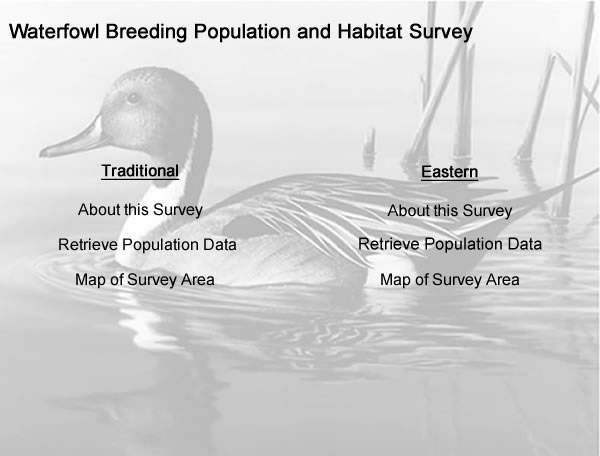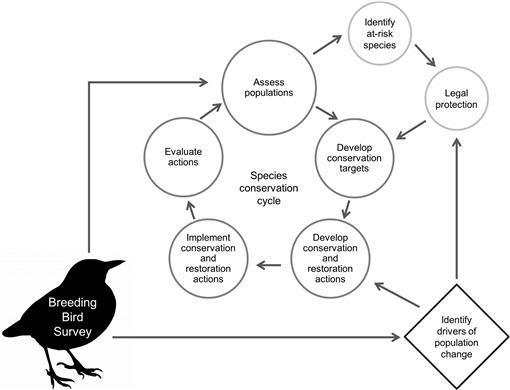Atlantic Flyway Breeding Waterfowl Survey. The protocols and guidelines available here are from various sources and are recommended as tested and reviewed methods for their intended purposes.
 If You Re A Licensed Migratory Bird Hunter You Re Hip
If You Re A Licensed Migratory Bird Hunter You Re Hip
Is estimated to be between 365 million to 988 million birds annually.

Usfws breeding bird survey. A Management Plan describing the methods to be used to avoid nesting birds andtheir nests eggs and chicks 3. The North American Breeding Bird Survey provides survey data on some secretive marsh birds. However BBS analyses provide indices of population change rather than estimates of population size precluding their use in developing abundance-based objectives and limiting applicability to harvest management.
First-time observer effects in the North American Breeding Bird Survey. Nesting Bird Surveys will be conducted prior to the commencement and during. The basic protocol of a Breeding Bird Survey hereafter BBS involves conducting a bird census along 245 miles of secondary roads.
These purposes include determining the presence or support for a negative finding for a particular species or its local status. The USGS Patuxent Wildlife Research Center and the Canadian Wildlife Service National Wildlife Research Center jointly coordinate the BBS program. Following a rigorous protocol BBS data are collected by thousands of dedicated participants along.
This survey will be necessary to determine presence or absence of owl. Gibbs and Melvin 1993. North American Breeding Bird Survey.
Surveys will observe breeding behavior and activity of all bird species. Fish and Wildlife Service USFWS uses data from the North American Breeding Bird Survey BBS to assist in monitoring and management of some migratory birds. The BBS is a long-term large-scale international avian monitoring program initiated in 1966 to track the status and trends of North American bird populations.
Fish Wildlife Services Migratory Bird Program state wildlife agencies and the Canadian Wildlife Service to estimate the size of breeding waterfowl populations across North America and to evaluate habitat conditions on the breeding grounds. Geological Survey cancelled the North American Breeding Bird Survey data from which is also important in monitoring bird abundance and regulating harvest of. Moreover many marsh bird species are secretive or inconspicuous.
The idea for the survey was the brainchild of Chandler Robbins. However BBS analyses provide indices of population change rather than estimates of population size precluding their use in developing abundance-based objectives and limiting. However many of the survey routes follow roads and thus do not adequately sample emergent wetlands Bystrak 1981.
How well do consistently monitored breeding bird. Species that are. Fish and Wildlife Service USFWS Canadian Wildlife Service CWS and state partners due to COVID-19 restrictions.
The NBMMRP should include the following. Bird mortality from window collisions in the US. Survey and Monitoring Protocols and Guidelines.
The Breeding Bird Survey BBS began in 1966 as part of an effort to gain information on North American bird populations. Waterfowl Breeding Population and Habitat Survey. For the first time in its 65-year history the Waterfowl Breeding Population and Habitat Survey has been cancelled by the US.
The BBS is a cooperative effort between the US. Wood Ducks Aix. Welcome to the North American Breeding Bird Survey BBS web site.
When we see all the glass and windows around us and how quickly these are becoming more prevalent in new building designs its no wonder this is such a large source of mortality. Patuxent Wildlife Research Center - Bird Population Studies. Species group summaries 1966-2019 Trend.
This survey is conducted each spring by the US. Interactive route data summary Interactive hierarchical model trend and annual index analysis Community dynamics analysis Mapdata and shapefiles-GIS Wildlife related software Wildlife related workshops. The USFWS and CWS also cancelled participation in the American Woodcock Singing-ground Survey Mid-continent Population Sandhill Crane Survey.
The United States Fish and Wildlife Service USFWS is looking for volunteers with a passion for birding in Alaska to conduct breeding bird surveys in eighteen 18 select locations throughout Alaska. Patuxent Wildlife Research Center PWRC produces innovative science to support natural resource management and meet our nations most pressing conservation challengesPWRC research topics include bird population dynamics ecotoxicology and the development of quantitative decision analysis tools. The survey was designed primarily to estimate breeding population size of mallards black ducks wood ducks and Canada geese.
Lawler and OConnor 2004. The annual survey estimates the breeding populations of key North American ducks and geese and assesses habitat conditions and therefore it is critical to establishing waterfowl hunting dates and daily bag limits for the subsequent year. Nest Survey Protocols describingthe nest survey methodologies 2.
Importantly the USFWS says it fully expects to allow waterfowl hunting during the 2021-2022 season. The USFWS and CWS also cancelled participation in the American Woodcock Singing-ground Survey Mid-continent Population Sandhill Crane Survey and Arctic Goose Banding Program. Fish and Wildlife Service USFWS uses data from the North American Breeding Bird Survey BBS to assist in monitoring and management of some migratory birds.
We conduct several national programs including the Bird Banding Lab and the. Potential roadside biases due to habitat changes along Breeding Bird Survey routes. Approval prior to commencement of the Project during the breeding season.
You may recognize Chans name as the primary author of the 1966 Golden Guide The Birds of North America. Geological Surveys Patuxent Wildlife Research Center and Environment Canadas Canadian Wildlife Service to monitor the status and trends of North American bird populations. Breeding population estimates for other species encountered during this survey frequently have unacceptably large standard errors.
 U S Fish Wildlife Service Migratory Bird Program Conserving America S Birds
U S Fish Wildlife Service Migratory Bird Program Conserving America S Birds
 Inside Region 3 U S Fish And Wildlife Service Midwest Region
Inside Region 3 U S Fish And Wildlife Service Midwest Region
 U S Fish Wildlife Service Migratory Bird Program Conserving America S Birds
U S Fish Wildlife Service Migratory Bird Program Conserving America S Birds
 Inside Region 3 U S Fish And Wildlife Service Midwest Region
Inside Region 3 U S Fish And Wildlife Service Midwest Region
 Evaluating The Design Of The Waterfowl Breeding Population And Habitat Survey
Evaluating The Design Of The Waterfowl Breeding Population And Habitat Survey
 Migratory Bird Data Center Waterfowl Breeding Population And Habitat Survey
Migratory Bird Data Center Waterfowl Breeding Population And Habitat Survey
 Inside Region 3 U S Fish And Wildlife Service Midwest Region
Inside Region 3 U S Fish And Wildlife Service Midwest Region
 The Role Of The North American Breeding Bird Survey In Conservation
The Role Of The North American Breeding Bird Survey In Conservation
 U S Fish And Wildlife Service Open Spaces Blog
U S Fish And Wildlife Service Open Spaces Blog
 Inside Region 3 U S Fish And Wildlife Service Midwest Region
Inside Region 3 U S Fish And Wildlife Service Midwest Region
Usfws 2019 Duck Population Status Report
0 comments:
Post a Comment